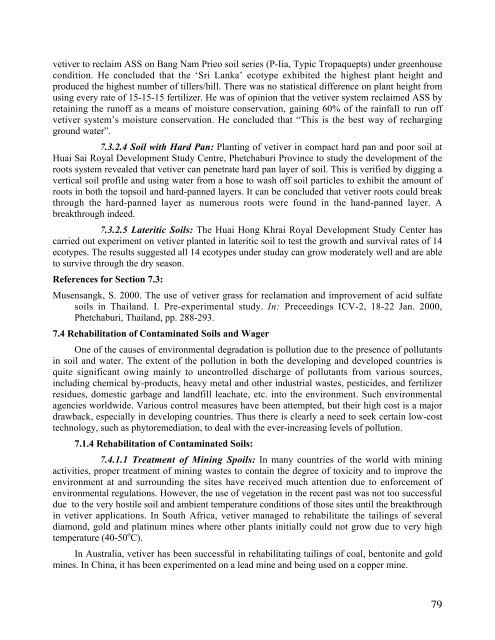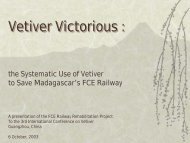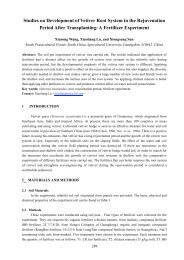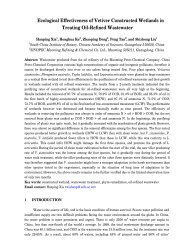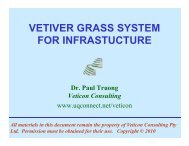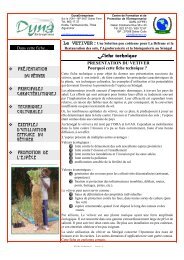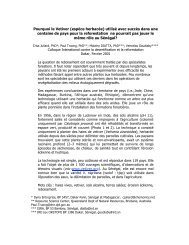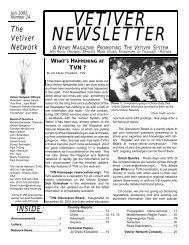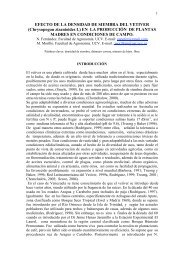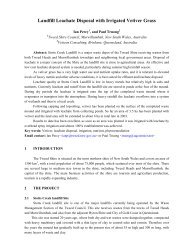Training manual - The Vetiver Network International
Training manual - The Vetiver Network International
Training manual - The Vetiver Network International
Create successful ePaper yourself
Turn your PDF publications into a flip-book with our unique Google optimized e-Paper software.
vetiver to reclaim ASS on Bang Nam Prieo soil series (P-Iia, Typic Tropaquepts) under greenhouse<br />
condition. He concluded that the ‘Sri Lanka’ ecotype exhibited the highest plant height and<br />
produced the highest number of tillers/hill. <strong>The</strong>re was no statistical difference on plant height from<br />
using every rate of 15-15-15 fertilizer. He was of opinion that the vetiver system reclaimed ASS by<br />
retaining the runoff as a means of moisture conservation, gaining 60% of the rainfall to run off<br />
vetiver system’s moisture conservation. He concluded that “This is the best way of recharging<br />
ground water”.<br />
7.3.2.4 Soil with Hard Pan: Planting of vetiver in compact hard pan and poor soil at<br />
Huai Sai Royal Development Study Centre, Phetchaburi Province to study the development of the<br />
roots system revealed that vetiver can penetrate hard pan layer of soil. This is verified by digging a<br />
vertical soil profile and using water from a hose to wash off soil particles to exhibit the amount of<br />
roots in both the topsoil and hard-panned layers. It can be concluded that vetiver roots could break<br />
through the hard-panned layer as numerous roots were found in the hand-panned layer. A<br />
breakthrough indeed.<br />
7.3.2.5 Lateritic Soils: <strong>The</strong> Huai Hong Khrai Royal Development Study Center has<br />
carried out experiment on vetiver planted in lateritic soil to test the growth and survival rates of 14<br />
ecotypes. <strong>The</strong> results suggested all 14 ecotypes under studay can grow moderately well and are able<br />
to survive through the dry season.<br />
References for Section 7.3:<br />
Musensangk, S. 2000. <strong>The</strong> use of vetiver grass for reclamation and improvement of acid sulfate<br />
soils in Thailand. I. Pre-experimental study. In: Preceedings ICV-2, 18-22 Jan. 2000,<br />
Phetchaburi, Thailand, pp. 288-293.<br />
7.4 Rehabilitation of Contaminated Soils and Wager<br />
One of the causes of environmental degradation is pollution due to the presence of pollutants<br />
in soil and water. <strong>The</strong> extent of the pollution in both the developing and developed countries is<br />
quite significant owing mainly to uncontrolled discharge of pollutants from various sources,<br />
including chemical by-products, heavy metal and other industrial wastes, pesticides, and fertilizer<br />
residues, domestic garbage and landfill leachate, etc. into the environment. Such environmental<br />
agencies worldwide. Various control measures have been attempted, but their high cost is a major<br />
drawback, especially in developing countries. Thus there is clearly a need to seek certain low-cost<br />
technology, such as phytoremediation, to deal with the ever-increasing levels of pollution.<br />
7.1.4 Rehabilitation of Contaminated Soils:<br />
7.4.1.1 Treatment of Mining Spoils: In many countries of the world with mining<br />
activities, proper treatment of mining wastes to contain the degree of toxicity and to improve the<br />
environment at and surrounding the sites have received much attention due to enforcement of<br />
environmental regulations. However, the use of vegetation in the recent past was not too successful<br />
due to the very hostile soil and ambient temperature conditions of those sites until the breakthrough<br />
in vetiver applications. In South Africa, vetiver managed to rehabilitate the tailings of several<br />
diamond, gold and platinum mines where other plants initially could not grow due to very high<br />
temperature (40-50 o C).<br />
In Australia, vetiver has been successful in rehabilitating tailings of coal, bentonite and gold<br />
mines. In China, it has been experimented on a lead mine and being used on a copper mine.<br />
79


